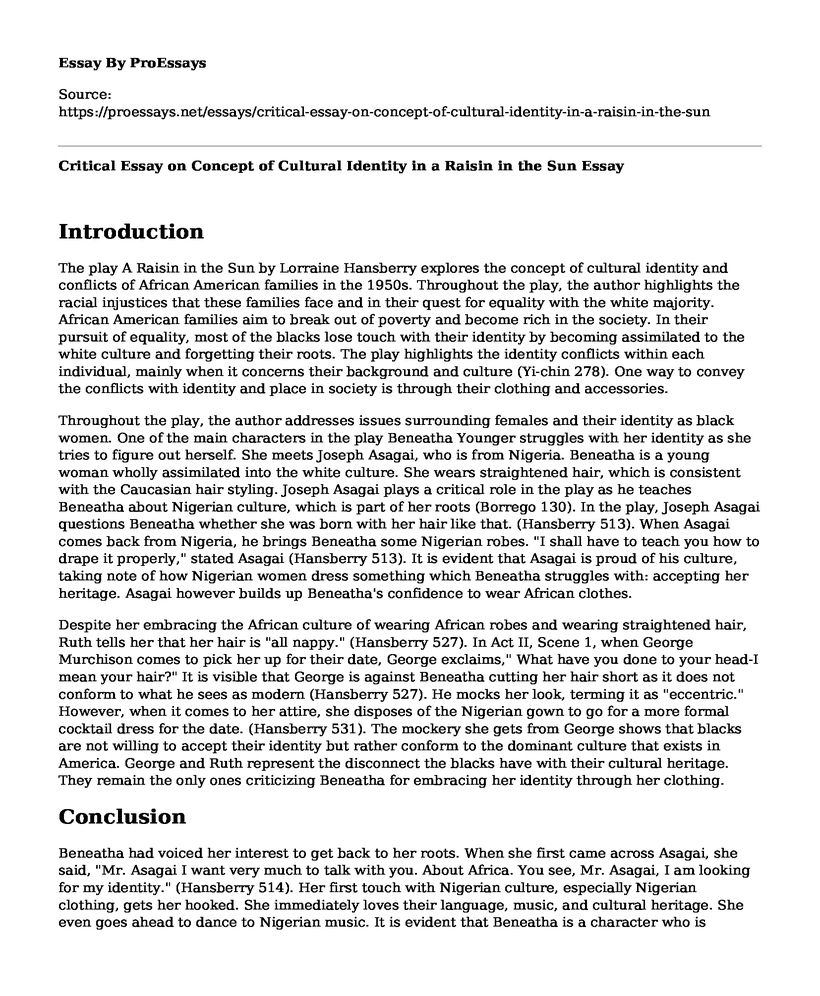Introduction
The play A Raisin in the Sun by Lorraine Hansberry explores the concept of cultural identity and conflicts of African American families in the 1950s. Throughout the play, the author highlights the racial injustices that these families face and in their quest for equality with the white majority. African American families aim to break out of poverty and become rich in the society. In their pursuit of equality, most of the blacks lose touch with their identity by becoming assimilated to the white culture and forgetting their roots. The play highlights the identity conflicts within each individual, mainly when it concerns their background and culture (Yi-chin 278). One way to convey the conflicts with identity and place in society is through their clothing and accessories.
Throughout the play, the author addresses issues surrounding females and their identity as black women. One of the main characters in the play Beneatha Younger struggles with her identity as she tries to figure out herself. She meets Joseph Asagai, who is from Nigeria. Beneatha is a young woman wholly assimilated into the white culture. She wears straightened hair, which is consistent with the Caucasian hair styling. Joseph Asagai plays a critical role in the play as he teaches Beneatha about Nigerian culture, which is part of her roots (Borrego 130). In the play, Joseph Asagai questions Beneatha whether she was born with her hair like that. (Hansberry 513). When Asagai comes back from Nigeria, he brings Beneatha some Nigerian robes. "I shall have to teach you how to drape it properly," stated Asagai (Hansberry 513). It is evident that Asagai is proud of his culture, taking note of how Nigerian women dress something which Beneatha struggles with: accepting her heritage. Asagai however builds up Beneatha's confidence to wear African clothes.
Despite her embracing the African culture of wearing African robes and wearing straightened hair, Ruth tells her that her hair is "all nappy." (Hansberry 527). In Act II, Scene 1, when George Murchison comes to pick her up for their date, George exclaims," What have you done to your head-I mean your hair?" It is visible that George is against Beneatha cutting her hair short as it does not conform to what he sees as modern (Hansberry 527). He mocks her look, terming it as "eccentric." However, when it comes to her attire, she disposes of the Nigerian gown to go for a more formal cocktail dress for the date. (Hansberry 531). The mockery she gets from George shows that blacks are not willing to accept their identity but rather conform to the dominant culture that exists in America. George and Ruth represent the disconnect the blacks have with their cultural heritage. They remain the only ones criticizing Beneatha for embracing her identity through her clothing.
Conclusion
Beneatha had voiced her interest to get back to her roots. When she first came across Asagai, she said, "Mr. Asagai I want very much to talk with you. About Africa. You see, Mr. Asagai, I am looking for my identity." (Hansberry 514). Her first touch with Nigerian culture, especially Nigerian clothing, gets her hooked. She immediately loves their language, music, and cultural heritage. She even goes ahead to dance to Nigerian music. It is evident that Beneatha is a character who is yearning to be in touch with her identity and going back to her roots helps her find peace in a world where they seem to be out of place (Doyle 3). The author places much emphasis on the fact that America is not a place for blacks, which is what Beneatha discovers throughout the play. Hansberry creates a radical character who is more of a revolutionist going against the traditional norms associated with blacks in America. She struggles to find her own identity rather than the one adopted from the dominant whites in America.
Work Cited
Borrego, Silvia del Pilar Castro. "Integration, Assimilation, and Identity in Lorraine Hansberry'sa Raisin in the Sun and Barbara and Carlton Molette's Rosalee Pritchett." Revista Canaria de Estudios Ingleses 70 (2015): 123-142.
Doyle, Rebecca M. ""Assimila-who-ever?" Communication Between Characters in A Raisin in the Sun Examined Using a Double-Consciousness Spectrum." Liberated Arts: a journal for undergraduate research 1.1 (2015): 3.
Hansberry, Lorraine. Lorraine Hansberry's A Raisin in the Sun. Samuel French, Inc., 1984.
Shih, Yi-chin. "Dance Scenes in Lorraine Hansberry's A RAISIN IN THE SUN." The Explicator 72.4 (2014): 278-281.
Cite this page
Critical Essay on Concept of Cultural Identity in a Raisin in the Sun. (2022, Mar 27). Retrieved from https://proessays.net/essays/critical-essay-on-concept-of-cultural-identity-in-a-raisin-in-the-sun
If you are the original author of this essay and no longer wish to have it published on the ProEssays website, please click below to request its removal:
- Transracial and Intercountry Adoptions Essay
- Compare and Contrast Essay on the Novels "The Metamorphosis" and "The Trial"
- Uncertainty, Ambiguity and Irony in Shakespeare's Macbeth Essay
- Macbeth and Lady Macbeth Relationship Essay
- The Death of American Dream in the Great Gatsby - Essay Sample
- Essay Example on Gyaru: Japan's Wild Fashion Subculture for Two Decades
- Paper Sample on Journey Over Destination: Lessons from Ithaka







